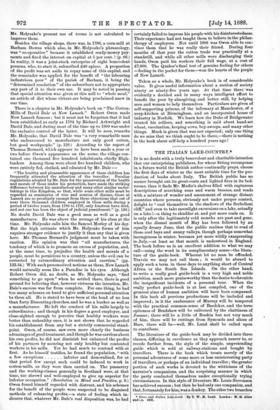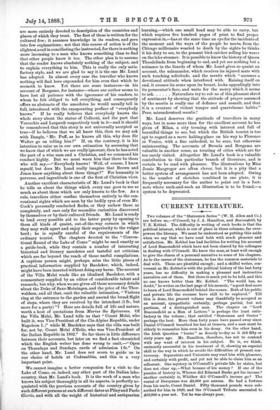THE ITALIAN LAICE-COITNTRY.* IT is no doubt with a truly
benevolent and charitable intention that our enterprising publishers, for whose fitting recompense in a future world the British author continually prays, choose the first days of winter as the most suitable time for the pro- duction of books about Italy. The British public has no sooner brought out its great-coats and lighted fires in its bed- rooms, than it finds Mr. Mudie's shelves filled with rapturous descriptions of scorching suns• and warm breezes, and reads with a mixture of wonder and amusement of strange distant countries where persons, obviously not under proper control, delight to "cool themselves in the shadows of the Serbelloni cliff," and even to take moonlight excursions on a lake, actually on a lake I—a thing to shudder at, and put more coals on. It is only after the legitimately cold months are past and gone, when the dismal month of May has been followed by an equally dreary June, that the public realises that to read of these cool bays and sunny valleys, though perhaps somewhat incongruous in winter, becomes yet more wildly exasperating in July,—at least as that month is understood in England. The book before us is an excellent addition to what we may call—using the word in its complimentary sense—the litera- ture of the guide-book. Whereat let no man be offended. Travels we may not call them ; it would be absurd to apply such a term in these days to anything short of Central Africa or the South Sea Islands. On the other hand, to write a really good guide-book is a very high and noble ambition, much more praiseworthy than the desire to chronicle the insignificant incidents of a personal tour. When the really perfect guide-book is at last compiled, one of the greatest aims of human ambition will have been compassed. In this book all previous productions will be included and improved ; in it the exuberance of Murray will be tempered with the practical common-sense of Baedeker, and the terse epitomes of Bradshaw will be enlivened by the chattiness of Joanne; there will be a little of Ruskin but not very much of him, there will be cuttings from Symonds and slices of Hare, there will be—well, Mr. Lund shall be called upon to contribute.
The literature of the guide-book may be divided into three classes, differing in excellence as they approach nearer to, or recede further from, the style of the simple, unpretending guide which is sold at railway-stations and bought by travellers. There is the book which treats merely of the personal adventures of some more or less uninteresting party of travellers, or perhaps of an individual traveller ; the greater portion of such works is devoted to the witticisms of the narrator's companions, and the surprising manner in which the party conducted themselves under exceptionally trying circumstances. In this style of literature Mr. Louis Stevenson has achieved success ; but then he had only one companion, and that, fortunately for him, was a donkey. The other two branches • Corns and Italian Lake-Land. By T. W. M. Lund. London : W. H. Allen itnd to. 1337. are more entirely devoted to description of the countries and places of which they treat. The first of these is written for the cultured few; it assumes knowledge in its readers, and goes into few explanations; not that this course of action is of the slightest avail in conciliating the instructed, for there is nothing more incensing to a man who knows something than to find that other people know it too. The other plan is to assume that the reader knows absolutely nothing of the subject, and to explain everything to him. This is really the only satis- factory style, and we are glad to say it is the one Mr. Lund has adopted. In almost every case the traveller who knows nothing will find here expounded for him even that which he seemeth to know. Yet there are some instances—in his account of Bergamo, for instance—where our author seems to have lost all patience with the ignorance of his readers, to whom he felt, obliged to tell everything, and consequently offers us abstracts of the anecdotes he would usually tell in full, introduced with the exasperating preface of "everybody knows." If he really believes that everybody knows the whole story about the statue of Colleoni, and the part that Verocchio and Leopardi respectively took in it—and it should be remembered that this story is not universally accepted as true—if he believes that we all know this, then we may ask with Dangle, "Mr. Puff, as he knows all this, why does Sir Walter go on telling him?" If, on the contrary, it is his intention to raise us in our own estimation by assuming that we know that of which we are really ignorant, then he his acted the part of a wise man and a Christian, and we commend his conduct highly. But we must warn him that there be those who will say,—" Everybody knows ! Well, of course, I know myself, but does Mr. Lund really imagine that Brown and Jones know anything about these things ?" For humanity is perverse, and ingratitude is one of the first of Christian vices.
Another excellent characteristic of Mr. Lund's book is that he tells us about the things which every one goes to see as much as about those which are only known to the few. As a rule, travellers either confine themselves entirely to the con- ventional sights which are seen by the bodily eyes of even Mr. Cook's personally conducted flocks, or they eschew these as completely, and care only for recondite curiosities discovered by themselves or by their cultured friends. Mr. Lund is ready to lend every possible aid to the latter party by opening to them all kinds of quaint, out-of-the-way corners in which they may walk apart and enjoy their superiority to the vulgar herd ; he is equally careful of the requirements of the ordinary tourist. The chapters devoted to the "Conven- tional Round of the Lake of Como" might be used exactly as a guide-book, while they contain a number of interesting historical and literary anecdotes and tasteful art criticism which are far beyond the reach of those useful compilations. A captions person might, perhaps, miss the little pieces of practical information supplied- by Baedeker, which, indeed, might have been inserted without doing any harm. The account of the Villa Melzi reads like an idealised Baedeker, with a commentary supplied by an editor of considerable talent and research; but why, when we are given all those necessary details about the Duke of Saxe-Meiningen, and the price of the Thor- waldsen, and all that, omit the valuable intimation, "Visitors ring at the entrance to the garden and ascend the broad flight of steps, where they are received by the intendant (1 fr., but more for a party)"? Here are details full of life and nature, -worth a host of quotations from Marius the Epicurean. Of the Villa Melzi, Mr. Lund tells us that "Count Melzi, who built it, was Vice-President of the Cis-Alpine Republic, under Napoleon I. ;" while 1i. Baedeker says that the villa was built for, not by, Count Melzi d'Erile, who was Vice-President of the Italian Republic in 1802." So far there is little difference between their accounts, but later on we find a fact chronicled which the English writer has done wrong to omit,—" Open on Thursdays and Sundays, cards of admission 1 fr." On the other hand, Mr. Lund does not scorn to guide us in our choice of hotels at Cadenabbia, and this is a very important point.
We cannot imagine a better companion for a visit to the Lake of Como, or, indeed, any other part of the Italian lake- country, than Mr. Lund's book. It is the work of a man who knows his subject thoroughly in all its aspects, is perfectly ac- quainted with the previous accounts of the country given by such different persons at such different dates as Pliny and Paolo Giovio, and with all the weight of historical and antiquarian
learning,—which one small head may be able to carry, but which requires five hundred pages of print to find proper expression in,—has at the same time an eye for the incidents of the moment and the ways of the people he meets, from the Chicago millionaire wearied to death by the sights he thinks it his duty to see, to the peasant bird-catcher selling his wares on the lake-steamer. It is possible to know the history of Queen Theodelinda from beginning to end, and yet see nothing but a. nuisance in the lizards of whom Mr. Lund gives so quaint an account, the salamander, which receives its injured mate with such touching solicitude, and the mantis which "assumes a. devotional attitude when interfered with. Raising itself on end, it crosses its arms upon its breast, looks appealingly into its persecutor's face, and waits for the mercy which it seems to ask Naturalists try to rob us of this pleasant shred of sentiment by showing that the attitude of prayer assumed by the mantis is really one of defiance and assault, and that it is a creature of violent temper and quarrelsome habits." Poor, misunderstood mantis !
Mr. Lund deserves the gratitude of travellers in many ways, but in none more than for the excellent account he has given of Milan, a city teeming with interest and full of beautiful things to see, but which the British tourist is too apt to regard as a mere halting-place on his way to Florence or Venice, with a fine cathedral, to be sure, but otherwise uninteresting. The accounts of Brescia and Bergamo are valuable in another sense, as treating of cities which are far too rarely visited. Altogether Mr. Lund's book is a valuable contribution to this particular branch of literature, and is certain to be read with pleasure. The illustrations by Miss Jessie Macgregor are often clever, but it is a pity that a better system of arrangement has not been adopted. Owing to the number of sketches combined in one plate, it is frequently necessary for the author to point out in a foot- note where such-and-such an illustration is to be found,—a system to be deprecated.



































 Previous page
Previous page